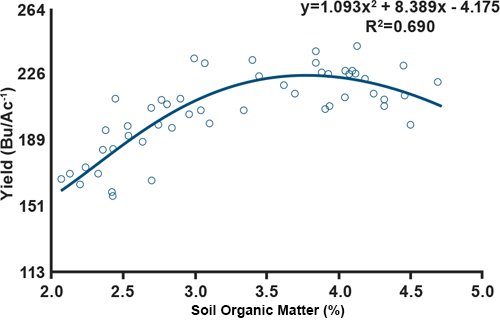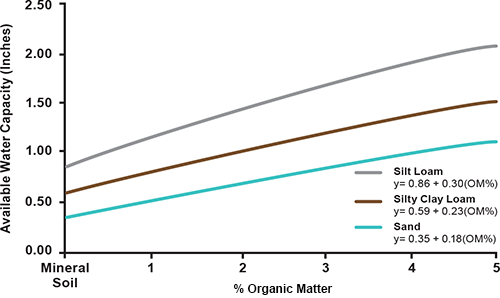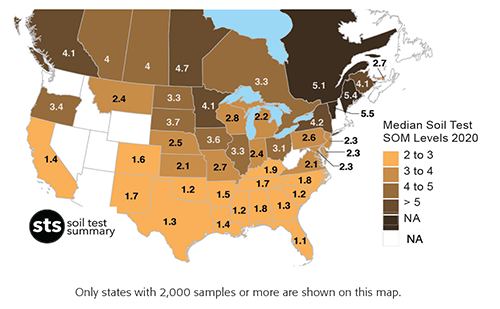
What is organic matter?
Organic materials are the fraction of the soil that includes approximately by weight, according to USDA-NRCS, 2014:
- 5% of living organisms
- 10% crop residues
- 33-50% decomposing organic matter (the active fraction)
- 33-50% stable organic matter (humus)
The active fraction of organic matter readily changes mass and form as it decomposes; thus, it is unstable in the soil and is most affected by management practices such as tillage, cover crops, and crop rotations (Carter, 2002). The rapid turnover of the active fraction can contribute to nutrient release for crops.
Humus on the other hand, is organic material that has been converted by microorganisms to a resistant state of decomposition. Humus improves soil fertility by acting as a reservoir for nutrients, increasing the water holding capacity of the soil, improving soil structure and friability, and providing a source of energy for living soil organisms.
The Benefits of Organic Materials
Increasing levels of organic matter improve the physical, chemical, and biological functions of the soil. The benefits of organic matter are summarized into the following five functions:
1. Biological Function
There are many benefits to organic matter, most of which begin with enhancing the biological diversity and activity in the soil. As organic matter increases, microbial activity tends to increase. Organic matter consists of 58% carbon, which is required in combination with other nutrients for microbial activity. Microorganisms excrete compounds that also act as a binding agent for soil particles, which can increase aggregate stability, water infiltration, and water holding capacity.
2. Nutrient Supply
Organic matter is a valuable nutrient source for plants and living organisms. As microorganisms increase their activity during warmer weather that occurs predominantly in the spring and summer, greater amounts of nutrients are cycled from organic forms into those that are inorganic and plant available.
For every % of organic matter in the top 6-inches of a medium-textured soil (silt and loam soils), approximately 10-20 lbs. of nitrogen, 1-2 lbs. of phosphorus, and 0.4-0.8 lbs. of sulfur are released per acre annually (USDA-NRCS, 2014). In addition, organic matter particles contain sites of negative charges (i.e., cation exchange capacity [CEC]) that attract and hold positively charged ions such as calcium, potassium, magnesium and ammonium-nitrogen.
3. Soil Structure
Organic matter causes soil particles to bind and form stable soil aggregates, which improves soil structure. With better soil structure, water infiltration through the soil increases and improves the soil’s ability to absorb and hold water as well as reduces the potential for surface crusting of the soil.
4. Water Holding Capacity
Soils with higher organic matter can infiltrate and store water at greater capacities. Organic matter behaves similar to a sponge, with the ability to absorb and hold up to 90 percent of its weight in water. A great advantage of the water-holding capacity of organic matter is that it will release most of the water that it absorbs.
Figure 2 shows the increase in plant available water with higher organic matter content across three different soils. Increasing organic matter 1% in the topsoil decreases the bulk density and increases the available water capacity by approximately 0.2-0.3 inches, which can be extremely valuable to help plants manage water through periods of moisture deficits.

5. Erosion Control
Greater aggregate stability is often the result of soils with more organic matter, which can increase water infiltration rates and result in reduced potential for water, soil and nutrients to erode. Data used in the universal soil loss equation indicate that increasing soil organic matter from 1 to 3% can reduce erosion 20 to 33% because of increased water infiltration and stable soil aggregate formation.
Management Practices to Increase Soil Organic Matter
Several factors such as climate, soil type, crop grown and specific management practices can each influence the amount of soil organic matter regionally or in specific fields; therefore, local conditions should be used as benchmarks for comparison when implementing practices to increase soil organic matter (Figure 3, STS).

Soils that have greater organic matter, such as those originally developed in prairies, annually cycled residues to the soil whereas forest soils with lower organic matter took longer to cycle the woody material back to the soil.
Building soil organic matter is a slow process that takes years or decades as it requires the addition of substantial plant biomass and protection from loss over time.
Three management strategies to build and maintain soil organic matter are:
- Minimize tillage or adopt no-till: Slows soil organic residue decomposition and gives greater protection to the soil from erosion
- Add crop residues by including cover crops, organic matter (e.g., residues, manure, etc.), or growing a high biomass/yielding crop rotation. Crop residues help protect the soil surface from raindrop impact and erosion and add carbon back to the soil.
- Soil test and apply advanced crop nutrition: Identify and correct yield-limiting factors to encourage greater growth of crops that can be returned to the soil. Adding crop residues that help build or maintain organic matter and including other potentially limiting essential crop nutrients can create more productive and sustainable cropping systems.